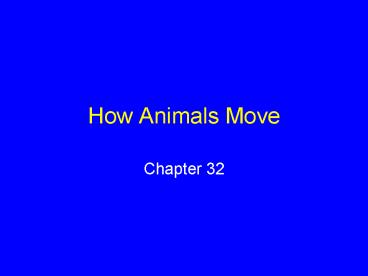How Animals Move - PowerPoint PPT Presentation
1 / 32
Title:
How Animals Move
Description:
biceps. triceps. Tendons Attach. Muscle to Bone. muscle ... BICEPS FEMORIS. GASTROCNEMIUS. Skeletal Muscle Structure. A muscle is made up of muscle cells ... – PowerPoint PPT presentation
Number of Views:303
Avg rating:3.0/5.0
Title: How Animals Move
1
How Animals Move
- Chapter 32
2
Skeleton
- A medium or structural element against which
contractile cells can act - Three types
- Hydrostatic
- Exoskeleton
- Endoskeleton
exoskeleton
3
Endoskeleton
- All vertebrates have endoskeletons
- Fins or limbs attach to skeleton at pectoral and
pelvic girdles
4
Human Skeleton
5
Functions of Bone
- Interact with muscle to enable movement
- Support and anchor muscles
- Enclose and protect internal organs
- Store calcium and phosphorus
- Produce blood cells
6
Long Bone Structure
- Compact bone
- Spongy bone
- Central cavity contains yellow marrow
7
Compact Bone Structure
- Mature compact bone consists of many cylindrical
Haversian systems
8
Bone Marrow
- Yellow marrow
- Fills the cavities of adult long bones
- Is largely fat
- Red marrow
- Occurs in spongy bone of some bones
- Produces blood cells
9
Long Bone Formation
10
Bone Remodeling
- In adults, bone building and bone breakdown
continue constantly - Osteoblasts deposit bone
- Osteoclasts secrete enzymes that degrade it
- Remodeling adjusts bone strength and helps
maintain blood calcium levels
11
Bone Density
- Exercise can increase bone density
- Osteoporosis is a decrease in bone density
- May occur when the action of osteoclasts outpaces
that of osteoblasts - May also occur as a result of inability to absorb
calcium
12
Joints
- Areas of contact or near contact between bones
- Fibrous joints
- Short connecting fibers join bones
- Synovial joints
- Move freely ligaments connect bones
- Cartilaginous joints
- Straps of cartilage allow slight movement
13
Skeletal Muscle
- Bundles of striped muscle cells
- Attaches to bone
- Often work in opposition
biceps
triceps
14
Tendons Attach Muscle to Bone
muscle
tendon
bursae
synovial cavity
15
Human Skeletal Muscles
TRICEPS BRACHII
BICEPS BRACHII
PECTORALIS MAJOR
DELTOID
TRAPEZIUS
SERRATUS ANTERIOR
EXTERNAL OBLIQUE
LATISSIMUS DORSI
RECTUS ABDOMINUS
GLUTEUS MAXIMUS
ADDUCTOR LONGUS
BICEPS FEMORIS
SARTORIUS
QUADRICEPS FEMORIS
GASTROCNEMIUS
TIBIALIS ANTERIOR
16
Skeletal Muscle Structure
- A muscle is made up of muscle cells
- A muscle fiber is a single muscle cell
- Each fiber contains many myofibrils
myofibril
17
Sarcomere
A myofibril is made up of thick and thin
filaments arranged in sarcomeres
sarcomere
sarcomere
sarcomere
sarcomere
Z band
Z band
Z band
18
Muscle Microfilaments
- Thin filaments
- Like two strands of pearls twisted together
- Pearls are actin
- Other proteins in grooves in filament
- Thick filaments
- Composed of myosin
- Each myosin molecule has tail and a double head
19
Sliding-Filament Model
- Sarcomere shortens because the actin filaments
are pulled inward, toward the sarcomere center
20
Sliding-Filament Model
- Myosin heads attach to actin filaments
- Myosin heads tilt toward the sarcomere center,
pulling actin with them
21
Role of Calcium in Contraction
- T tubules in the sarcoplasmic reticulum relay
signal - Calcium ions are released
22
Nervous System Controls Contraction
- Signals from nervous system travel along spinal
cord, down a motor neuron - Endings of motor neuron synapse on a muscle cell
at a neuromuscular junction
23
Contraction Requires Energy
- Muscle cells require huge amounts of ATP energy
to power contraction - The cells have only a very small store of ATP
- Three pathways supply ATP to power muscle
contraction
24
ATP for Contraction
25
Motor Unit
- One neuron and all the muscle cells that form
junctions with its endings - When a motor neuron is stimulated, all the muscle
cells it supplies are activated to contract
simultaneously - Each muscle consists of many motor units
26
Twitches and Tetanus
27
Muscle Tension
- Mechanical force a contracting muscle exerts on
an object - For a muscle to shorten, muscle tension must
exceed the load that opposes it - The load may be the weight of an object or
gravitys pull on the muscle
28
Two Main Types of Contraction
- Isotonic contraction
- Muscle visibly shortens moves a load
- Tension remains constant as the muscle changes
length - Isometric contraction
- Muscle does not change length
- Tension is insufficient to move load
29
Muscle Fatigue
- An inability to maintain muscle tension
- Occurs after a period of tetanic contraction
- Different types of muscle show different fatigue
patterns
30
Muscular Dystrophies
- A class of genetic disorders where muscles
progressively weaken and degenerate - Duchenne muscular dystrophy is the most common
among children - Myotonic muscular dystrophy is the most common
among adults
31
Aging Muscles
- Over time, the number and size of muscle fibers
decreases
32
Clostridium
- Clostridium botulinum causes botulism, stopping
the release of acetylcholine, a neurotransmitter
that enables muscle contraction - Clostridium tetani causes tetanus, blocking the
neurotransmitters GABA and glycine, which leads
to uninhibited muscle contraction































